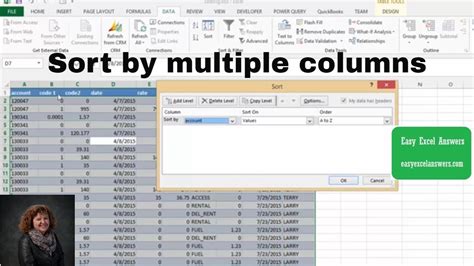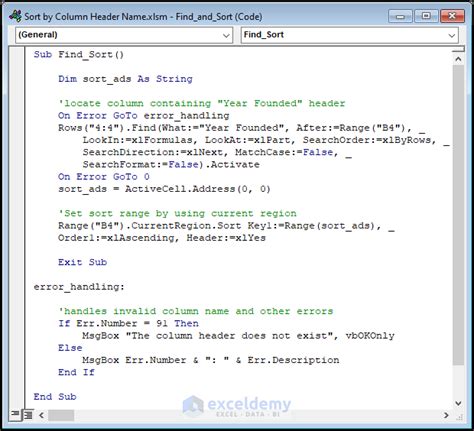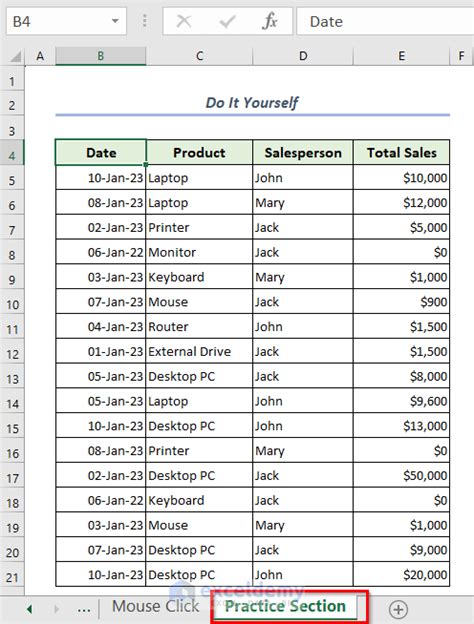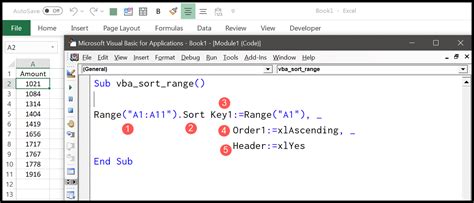Sorting data in Excel is a common task that can be easily automated using VBA. Whether you're working with a small dataset or a large one, VBA provides an efficient way to sort your data with precision. In this article, we'll explore how to sort a range in Excel using VBA, covering the basics, examples, and practical applications.
Why Use VBA for Sorting in Excel?
Before we dive into the details, let's briefly discuss why you might want to use VBA for sorting in Excel. While Excel's built-in sorting features are powerful, VBA offers several advantages:
- Automation: VBA allows you to automate the sorting process, saving you time and effort.
- Customization: With VBA, you can create custom sorting routines that cater to specific needs.
- Integration: VBA can be integrated with other Excel features, such as worksheets, charts, and formulas.
Basic VBA Sorting Syntax
To sort a range in Excel using VBA, you'll need to use the Range.Sort method. The basic syntax is as follows:
Range("RangeName").Sort Key1:=Range("KeyRange"), Order1:=xlAscending, Header:=xlGuess
Here's a breakdown of the parameters:
Range("RangeName"): The range you want to sort.Key1:=Range("KeyRange"): The range that contains the sort key (i.e., the column you want to sort by).Order1:=xlAscending: The sort order (eitherxlAscendingorxlDescending).Header:=xlGuess: Whether the range has a header row (eitherxlGuess,xlYes, orxlNo).
Sorting a Range with VBA: Examples
Let's explore some examples to illustrate how to sort a range in Excel using VBA.
Example 1: Sorting a Range by a Single Column
Suppose you have a range A1:C10 that contains data, and you want to sort it by the values in column A in ascending order.
Sub SortRangeBySingleColumn()
Range("A1:C10").Sort Key1:=Range("A1:A10"), Order1:=xlAscending, Header:=xlNo
End Sub
Example 2: Sorting a Range by Multiple Columns
Now, let's say you want to sort the same range by multiple columns: first by column A, then by column B.
Sub SortRangeByMultipleColumns()
Range("A1:C10").Sort _
Key1:=Range("A1:A10"), Order1:=xlAscending, _
Key2:=Range("B1:B10"), Order2:=xlDescending, _
Header:=xlNo
End Sub
Example 3: Sorting a Range with a Header Row
If your range has a header row, you can modify the code to account for it.
Sub SortRangeWithHeader()
Range("A1:C10").Sort _
Key1:=Range("A2:A10"), Order1:=xlAscending, _
Header:=xlYes
End Sub
Practical Applications of VBA Sorting
VBA sorting has numerous practical applications in Excel, such as:
- Automating data analysis: By sorting data automatically, you can speed up data analysis tasks.
- Creating custom reports: VBA sorting can help you create custom reports that cater to specific needs.
- Streamlining workflows: By automating sorting tasks, you can streamline your workflows and reduce manual effort.
Common Errors and Troubleshooting
When working with VBA sorting, you may encounter errors or issues. Here are some common errors and troubleshooting tips:
- Error 1004: "Sort method of Range class failed"
- Solution: Check that the range is correctly specified and that the sort key is valid.
- Error 438: "Object doesn't support this property or method"
- Solution: Verify that the
Range.Sortmethod is used correctly and that the range is a valid object.
- Solution: Verify that the
Gallery of Excel VBA Sorting Examples
Here are some additional examples of VBA sorting in Excel:
Excel VBA Sorting Examples










Frequently Asked Questions
Here are some frequently asked questions about VBA sorting in Excel:
Q: Can I sort a range by multiple columns?
A: Yes, you can sort a range by multiple columns using the Key1 and Key2 parameters.
Q: How do I specify the sort order?
A: You can specify the sort order using the Order1 parameter, which can be either xlAscending or xlDescending.
Q: Can I sort a range with a header row?
A: Yes, you can sort a range with a header row by setting the Header parameter to xlYes.
Conclusion
Sorting a range in Excel using VBA is a powerful and flexible way to automate data analysis tasks. By mastering VBA sorting, you can streamline your workflows, create custom reports, and reduce manual effort. Whether you're working with small datasets or large ones, VBA sorting is an essential skill to have in your Excel toolkit.
We hope this article has provided you with a comprehensive understanding of VBA sorting in Excel. If you have any questions or need further assistance, feel free to comment below or share this article with your colleagues.
